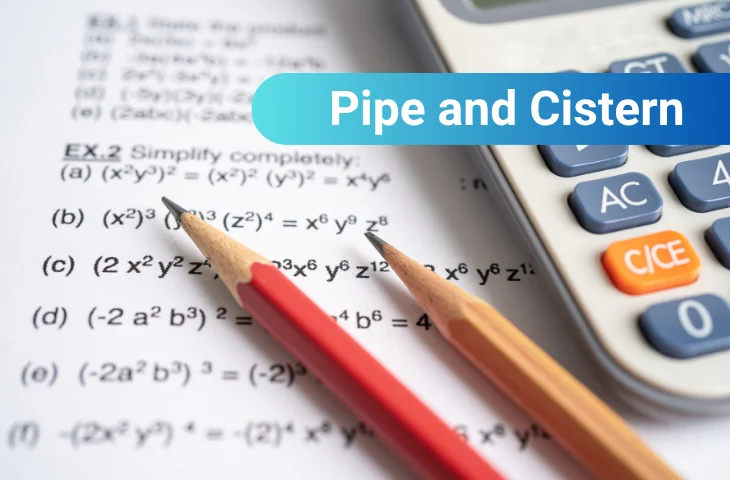Quantitative Aptitude is a key component of most competitive exams, and one of the most practical chapters is Pipe and Cistern. This topic is a variation of Time and Work, focused on fluid-based problems like filling or emptying tanks using inlets and outlets. In this blog, we have provided all the details about Pipe and Cistern concepts, types of questions asked, time-saving tricks, strategies, and more.
What Is Pipe and Cistern in Quantitative Aptitude?
Pipe and Cistern questions deal with the rate of flow of liquid in or out of a tank. Pipes can fill (inlets) or empty (outlets) a tank, and the problem revolves around how long it takes to fill or empty the cistern.
Why it Appears in Exams:
This topic checks:
- Basic time-work concept
- Logical application of speed-flow analogy
- Efficiency understanding of combined work (inlets vs outlets)
Skills Required:
- Calculation speed
- Fraction handling
- Time-work logic
- Visualization of filling/emptying process
Why Is Pipe and Cistern Important in Competitive Exams?
Pipe and Cistern is one of the easier chapters that, if prepared well, can help you score full marks in the exam from this topic
| Exam | No. of Questions | Difficulty |
| SSC CGL / CHSL | 1–2 | Easy |
| IBPS PO / SBI PO | 1–2 | Moderate |
| RRB NTPC / Group D | 1 | Easy |
| State PSC / Police | 1–2 | Moderate |
Terms Used in Pipe and Cistern Questions
Terms commonly used in pipe and cistern types of questions are as follows:
| Term | Details |
| Inlet Pipe | A pipe that fills the tank |
| Outlet Pipe | A pipe that empties the tank |
| Net Work | Total work done when both inlet and outlet operate together |
| Efficiency (Rate) | Part of the tank filled/emptied in 1 hour or 1 minute |
| LCM Method | Used to avoid fractional calculations (consider tank as 60L, 120L) |
| Negative Work | Outlet pipe’s work is taken as negative in combined equations |
Concepts of Pipe and Cistern Questions
Some of the common concepts used while solving pipe and cistern questions are as follows:
| Concept | Explanation |
| Inlet fills in ‘x’ hr | 1/x part of tank is filled per hour |
| Outlet empties in ‘y’ hr | 1/y part is emptied per hour (taken as -1/y in equations) |
| Net Rate Formula | Net rate = (Inlet rate – Outlet rate) |
| Time to Fill/Empty | Time = Work ÷ Net Rate |
| If both pipes open together | Total time = 1 / (1/x – 1/y) or 1 / (1/x + 1/y), depending on in/outlet |
| Partial Fill Problem | Use ratio method or unitary method for “half-filled” scenarios |
What Are the Types of Pipe and Cistern Questions in Quantitative Aptitude?
Types of questions commonly asked from the topic are as follows:
- Direct Questions: One inlet or outlet with simple time calculation
- Combined Pipes: Both pipes operate together (positive and negative work)
- Leakage-based: Leakage reduces flow; subtract leakage rate from inlet
- Variable Pipes: Pipes open/close after certain time
- Cyclic Pattern: Pipes open in fixed order repeatedly
Pipe and Cistern Formulas
Here are the time-saving formulas and logical templates:
- If a pipe fills a tank in x hours, its rate = 1/x
- If a pipe empties a tank in y hours, its rate = –1/y
- If both pipes work together, net rate = (1/x – 1/y) or (1/x + 1/y)
- If the tank is partially filled/emptied, apply the formula: Time=VolumeNet Rate\text{Time} = \frac{\text{Volume}}{\text{Net Rate}}Time=Net RateVolume
- LCM shortcut: Assume tank volume = LCM of individual times to simplify
Pipe and Cistern Tricks for SSC CGL and Other Exams
Some of the quick time saving tricks are as follows:
- Assume Tank Capacity as LCM of all time values (e.g., 60L, 120L)
- Treat outlet as negative work when working with both inlet and outlet
- Skip unit conversion unless time is in minutes and rate is per hour
- Use ratio method for partial fill questions
- Cross-check units (minutes/hour) before applying formulas
- Reverse solve from options if stuck with calculations
Solved Pipe and Cistern Questions from 2024–25 Exams
Recent memory-based and mock-based problems are as follows:
1. Asked in SSC CGL 2024 Tier 1 – Shift 2 (Memory-Based)
Q: A pipe fills a tank in 6 hours. A second pipe empties it in 9 hours. If both are opened together, in how much time will the tank be filled?
A:
Rate of fill = 1/6, Rate of empty = –1/9
Net rate = 1/6 – 1/9 = (3–2)/18 = 1/18
Ans: 18 hours
2. From IBPS PO Prelims 2024 (Mock Based)
Q: Two inlet pipes can fill a tank in 12 hours and 18 hours respectively. How long will they take together?
A:
Combined rate = 1/12 + 1/18 = (3+2)/36 = 5/36
Time = 36/5 = 7.2 hours
3. Based on Memory – RRB NTPC 2024 Shift 1
Q: A tank is filled in 10 hours by an inlet. There’s a leak that empties the full tank in 20 hours. How long will it take to fill the tank?
A:
Net rate = 1/10 – 1/20 = (2–1)/20 = 1/20
Ans: 20 hours
Pipe and Cistern Concepts for Bank Exams
Bank exams like IBPS/SBI often ask questions like:
- Pipes with delays (e.g., second pipe opens after 3 hours)
- Pipes working alternately
- Leak detection or net loss of efficiency
Example:
A pipe can fill a tank in 10 hours. After 4 hours, a leak is detected that empties it in 20 hours. How much more time to fill the tank?
(Solve in 2 parts: 4 hours full, then net rate with leak)
Common Mistakes to Avoid while Solving Pipe and Cistern
Some of the common types of mistakes aspirants must avoid while solving questions from Pipe and Cistern are as follows:
- Wrong sign for outlet – Always treat outlet as negative work
- Ignoring time units – Convert minutes to hours or vice versa
- Adding instead of subtracting rates – When one fills and one empties
- Incorrect tank assumption – Use LCM or 1 as tank capacity for simplicity
- Misreading delays/opening times – Carefully read timing of pipe openings
What Are Related Topics I Should Revise Next?
Topics you should revise next are as follows:
- Questions based on Time and Distance
- Rules and Practice Questions of Trigonometry
- Shortcuts and Patterns of Number Series
- Various types of Questions Based on Data Interpretation
- Tricks & Examples of Problems on Age based Questions
FAQs
They are based on time and work, involving pipes filling or emptying a tank.
Divide 1 by the time it takes to fill or empty the tank.
Treat outlet work as negative when calculating combined rate.
Net rate = 1/x ± 1/y, depending on inlet or outlet involvement.
It involves subtracting the leak’s rate from the inlet pipe’s rate.
- BOI Apprentice Salary 2025, Check Stipend Details
- Upcoming Bank Exams 2026: SBI, IBPS, IBPS RRBs, Insurance Exams
- Bank of India Credit Officer Syllabus 2025, Check Exam Pattern
- Punjab and Sind Bank LBO Interview Result 2025 Out, Download PDF
- SSC CGL Tier 2 Previous Year Paper, Download Free PDF
- SSC CGL 2025 Tier 1 Question Papers, Shift-Wise PYPs, Download PDFs

Hi, I’m Aditi. I work as a Content Writer at Oliveboard, where I have been simplifying exam-related content for the past 4 years. I create clear and easy-to-understand guides for JAIIB, CAIIB, and UGC exams. My work includes breaking down notifications, admit cards, and exam updates, as well as preparing study plans and subject-wise strategies.
My goal is to support working professionals in managing their exam preparation alongside a full-time job and to help them achieve career growth.
